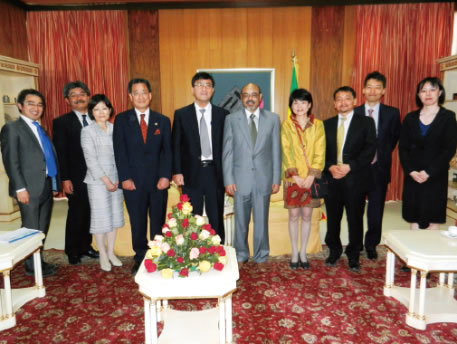Stories from the Field 09
Supporting Nation Building
in Ethiopia through Policy Dialogue
– Developing “Kaizen” as a popular movement to create a nation built
on manufacturing

Members of the Industrial Policy Dialogue observe a leather shoes manufacturing factory in Ethiopia. (Photo: Kenichi Ono)
The National Graduate Institute for Policy Studies (GRIPS) Development Forum (GDF)1 is one of GRIPS’s research projects. Working together with JICA, from June 2009 to July 2016 GDF engaged in a series of bilateral industry policy dialogues with the Ethiopian government. This project was launched upon a request from Mr. Meles Zenawi, former Prime Minister of Ethiopia, who had a tremendous interest in the experiences of East Asian industrial development.
The starting point for this industrial policy dialogue dates back to July 2008, when Prof. Kenichi Ohno and Prof. Izumi Ohno of GDF attended the African Task Force Meeting, jointly hosted by JICA and the Initiative for Policy Dialogue (IPD)2 in Ethiopia.
Prof. Izumi Ohno explains, “In the morning of the second day of the meeting, Prime Minister Meles arrived at the venue earlier than anyone else and was waiting for the arrival of Prof. Joseph E. Stiglitz. While he was waiting I approached him and handed him a copy of a book that we had authored on Japan’s experiences of development assistance to other East Asian countries. Chapter seven was about a ‘Kaizen’ project implemented by JICA in Tunisia3.” The following week Prime Minister Meles called the Japanese Ambassador to Ethiopia to his office and strongly requested two-part cooperation from Japan, comprising: (i) “Kaizen” (factory improvement) by JICA to vitalize Ethiopia’s manufacturing industry; and (ii) policy dialogue with GRIPS in order to learn about Japan’s development policy.
Starting in this way, the industrial policy dialogue between GRIPS and Ethiopia was the first time for Japan to engage in development policy support in Africa. The project comprised two phases, the first from June 2009 to May 2011 and the second from January 2012 to July 2016 and the dialogue was implemented at three levels: (i) direct dialogue and correspondence with the prime minister, (ii) high-level forums with state ministers and ministers from relevant ministries, and (iii) interaction and joint work at the policy operational staff level.

Mr. Meles Zenawi, Former Prime Minister of Ethiopia (center) with Prof. Kenichi Ohno and Prof. Izumi Ohno on either side. (Photo: Kenichi Ohno)
In detail, the project was advanced in the specific form of Japan and Ethiopia each organizing a report on the theme fixed based on the relevance to the situation and policies in Ethiopia. Based on the reports, discussions in high-level forums have taken place. The results and points of discussion in these meetings were reported to the Prime Minister and further opinions exchanged. Another major characteristic of the project was that the policy dialogue was implemented in tandem with industry assistance measures by JICA, including Kaizen programs.
What Prof. Kenichi Ohno and Prof. Izumi Ohno felt most keenly through this industrial policy dialogue process was the passion of Prime Minister Meles for nation building. Prof. Kenichi Ohno says, “No sooner had we begun the dialogue than we received a 16-page letter penned by Prime Minister Meles himself. The letter detailed the prime minister’s theories on the state, his philosophy for nation building in Ethiopia, and also his strong expectations for our policy dialogue. It was inspiring to read directly about the passion of a national leader.”
Although former Prime Minister Meles passed away in 2012, his vision for Ethiopia has been continued by current Prime Minister Hailemariam Desalegn. And it was based on a strong request from the new prime minister that the industrial policy dialogue has continued. Ethiopia’s Second Growth and Transformation Plan (GTP2) details a vision for a nation built on manufacturing, centering on light industry, with proposals from Japan that originated in the policy dialogue having been incorporated into government policy, including the development of a national “Kaizen” movement towards the realization of GTP2.
Prof. Kenichi Ohno notes, “Although the quantity of Japan’s private sector investment in Ethiopia may be small compared to that of western countries and others such as China, Turkey and India, I believe that through the industrial policy dialogue we have been able to provide intellectual support for industrial development and industrialization, which has magnified Japan’s presence in terms of qualitative aspects.”
Both Prof. Kenichi Ohno and Prof. Izumi Ohno have experience of researching development policy in various developing countries, and they both agree there is a tremendously strong motivation for engaging in Ethiopia. Prof. Kenichi Ohno says, “You could liken it to the Meiji Restoration in Japan in the 19th century. Being able to join the prime minister and officials of Ethiopia, who should really be called pioneers for national growth and development, and consider together the direction for building the nation, is highly motivating and satisfying. As nation building requires decades to accomplish, we will continue to work with Ethiopia and make it our lifework.”
It can be expected that the intellectual dialogue between Japan and Ethiopia towards high-quality national growth will continue on a firm and dynamic footing.
*1 A research project launched in 2002 to engage in policy studies and outreach activities in the fields of Japan’s ODA and economic cooperation.
*2 A think tank headed by Nobel Laureate in Economics and Professor of Columbia University, Prof. Joseph E. Stiglitz.
*3 This was a project implemented largely on the ground in the production facilities of manufacturing industries, which sought to improve quality and productivity. It incorporated the Japanese concept of “5S,” taken from the initial letters of the Japanese words Seiri (Sort), Seiton (Straighten), Seiso (Shine), Seiketsu (Standardize), and Shitsuke (Sustain), as well as quality control cycles, and was a bottom-up approach through which local employees shared ideas and proposed new methods for improving efficiency.
<< Previous Page Next Page >>
Main Text | Statistics and Reference Materials | Stories from the Field | Master Techniques from Japan to the World | ODA Topics
